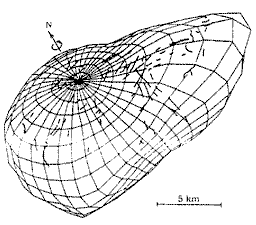 |
Science Frontiers ONLINE No. 94: Jul-Aug 1994 |
|
|
The shattering of 951 gaspra
951 Gaspra is an irregular asteroid with an average radius of 6.1 kilometers. Located at the inner edge of the main asteroid belt between Mars and Jupiter, Gaspra is believed to be composed mainly of olivine, pyroxene, and nickel-iron.
 Shape model of Gaspra showing the locations of the grooves. |
"We report the discovery of grooves in Galileo high-resolution images of Gaspra. These features, previously seen only on Mars' satellite Phobos, are most likely related to severe impacts. Grooves on Gaspra occur as linear and pitted depressions, typically 100-200 m wide, 0.8 to 2.5 km long, and 10-20 m deep. Most occur in two major groups, one of which trends approximately parallel to the asteroid's long axis, but is offset by some 15�, the other is approximately perpendicular to this trend. The first of these directions falls along a family of planes which parallel three extensive flat facets identified by Thomas et al. The occurrence of grooves on Gaspra is consistent with other indications (irregular shape, cratering record) that this asteroid has evolved through a violent collisional history."
(Veverka, J., et al; "Discovery of Grooves on Gaspra," Icarus, 107:72, 1994.)
Comment. The pits along Gaspra's cracks, as on Phobos, suggest the violent expulsion of gases. Where could these gases have come from? "Sandblows" are sometimes formed during terrestrial earthquakes as natural gases and other fluids are squeezed out of the earth's porous outer crust. Could Gaspra harbor primordial methane? If so, is it biogenic or abiogenic?
Reference. An entire chapter on the anomalies of asteroids can be found in our catalog: The Sun and Solar System Debris. Details here.